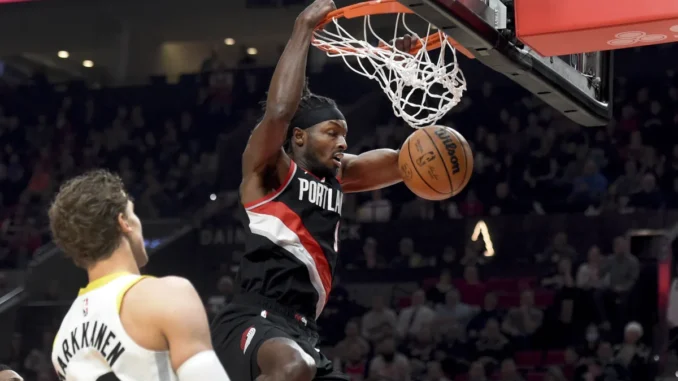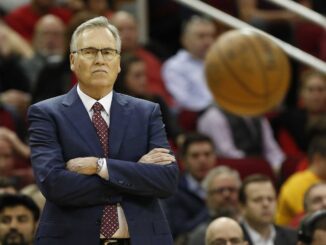
For a fleeting moment, post All-Star break, it looked like the Portland Trail Blazers were finally putting it together. Even with the season-ending injury to Deandre Ayton in early February, the mismatched combination of young stars, declining veterans, and forgotten role players that make up this year’s Blazer squad was starting to gel, seemingly at the right time. With the playoffs a little over a month away and only the talented but equally dysfunctional Phoenix Suns and Dallas Mavericks ahead of them, sneaking into at least a play-in spot seemed achievable and possibly inevitable.
Fast forward a month, and those hopes have most likely been dashed, with Chauncy Billups’ team struggling against a tougher schedule this month, and teams ahead of them bouncing back at the same time. With only six games left in the season, the Blazers find themselves in twelfth place in the West, behind Phoenix and three and a half games back of the now tenth-seated Sacramento Kings. The hope was fun, a necessary reprieve from three years of concentrated tanking and ideally a blueprint for next season and beyond. Now is the time to focus on the draft and a pivotal summer in terms of shaking up a promising but extremely flawed roster.
The number one priority for Joe Cronin and the Blazers front office this summer should be offloading Jerami Grant. Acquired before the 2022-23 season in a last-ditch attempt to construct a contender around Damian Lillard, and then re-signed in an even more desperate attempt to keep Lillard the following summer, Grant’s tenure in Portland has been a wholly disappointing one. He’s a player that fits best as a third or fourth option, and having to be the 1A (or 1B behind Anfernee Simons) offensive option on a clearly tanking team has not been ideal. Unfortunately, the perfect time to trade him was last offseason, coming off a 23-24 campaign where he shot over 40% from three and averaged 21 points per game, the second highest mark of his career.
This season has seen those numbers take a significant hit, with Grant shooting below 40% from both the field and from three. It’s also the third season in a row where he will not play nearly a full slate, missing 19 games in 22-23, 28 games last year, and likely more than 30 games this year. Instead of this drop in performance, shaky health history-wise, and a hefty ~$102 million left on his current deal, the Blazers might have to attach a pick or assets to offload what could’ve been a solid trade piece. However, it’s a hit they have to take, as Toumani Camara and Deni Avdija are both younger, performing better, and occupy the same position on the roster as Grant.
The other two names that scream “trade me” are Matisse Thybulle and Robert Williams. Both are defensive-minded role players technically entering their prime, but have struggled to stay on the court recently. They also come with a price tag that feels a little too pricey given their production up to this point. Williams, in particular, should be a reclamation project many teams will have their eye on, as when healthy, he can be one of the best defensive players in the league. In his only season playing above 61 games (2021-22), he finished seventh in Defensive Player of the Year voting and anchored a Boston team that won 51 games and ranked second in league-wide defensive rating. The injury history is pretty extreme, though, with Williams only playing 26 combined games for the Blazers after being acquired in the 2023 offseason. Luckily, he only has a year left on his contract, and Portland should be able to offload his expiring money (~$13 million) this summer, given the defensive promise he brings and the fact that he is only 27.
Thybulle was also brought in as a potential ceiling raiser in terms of defense, acquired from Philly in the middle of the 22-23 season in the mad jumble that was Lillard’s last year in Portland. Last season, he played a solid 65 games and averaged over 20 minutes per game, but in terms of overall performance, the bloom was quite quickly off the rose. His defensive prowess in Philly had been built off the power of highlight plays and impressive block/steal numbers, all while never being a full-time starter, mainly due to his offensive limitations. That dichotomy was on full display in 24-25, as he shot under 40% from the field and under 35% from three but served his role as an active disruptor on the defensive side. Like Williams, he will be an expiring contract heading into next year. It seems plausible that a team needing an athletic, switchable wing stopper will be willing to take on his $11.5 million salary for a season.
The last two names that should be brought up in this conversation are Anfernee Simons and Deandre Ayton, and they deserve to be brought up together as their trade necessity is less due to their age or talent or injury history and simply more to do with the future of the Blazers’ starting five. Scoot Henderson and Shaedon Sharpe are the future of Portland’s backcourt, and both have continued to show more and more flashes of the explosive talent Cronin and co. saw when they drafted them. Due to the rocky nature of his rookie year, it made some sense to bring Scoot off the bench to start the season, but as he’s quickly improved as a ball handler and creator, it’s been less and less defensible not to give him lead guard duties. This is no shade at Simons, who has elevated his game over his eight seasons in the league, and has become a deadly scorer and shooter in his own right. The simple fact of the matter is that he needs to be moved aside for his younger counterparts, and he is both too good and too expensive ($27 million expiring for 25-26) to be shifted into a bench role. Hopefully, a team needing a number one/two option and starting shooting guard like Orlando or Milwaukee comes knocking.
A similar positional quandary exists for Ayton. When he first arrived in Portland, he did so as the centerpiece of the Damian Lillard trade, a former number one pick who had impressed to start his career but had both played and acted his way out of Phoenix. The concerns were obvious, increasing examples of low effort play and clear regression from the Suns’ 2021 playoff run that saw Ayton dominate against quality competition. But for a team at the start of a rebuild like Portland, the talent and physical attributes were too tantalizing to turn down, especially for a team that hadn’t had an All-Star center in decades. Over the past two years, however, Ayton has shown little to no improvement, bringing the same off-and-on, lackadaisical, uninspired play to the Blazers for which he was run out of Phoenix. In addition, Portland happened to draft his direct replacement last summer, selecting Donovan Clingan with the seventh pick out of UConn. While he comes with a heavy price tag ($35 million for 25-26), like Simons, Williams, and Thybulle, he is expiring after next season. He is still a viable starter, so teams needing a seven-footer should create a suitable market.
Will all these players successfully be traded before the 25-26 season commences? That is a question only Joe Cronin, his team, and ownership really know, but for Portland fans who hope to watch a contending squad sooner rather than later, this is the path forward. Yes, it involves parting with some fan favorites, maybe even giving up on a player a few years before they hit their prime. But the future of Blazer basketball lies within the development of Henderson, Sharpe, Camara, Avdija, and Clingan, and to see what that starting five can really do on a basketball court, subtractions need to be made.
Stats and info via Basketball Reference



